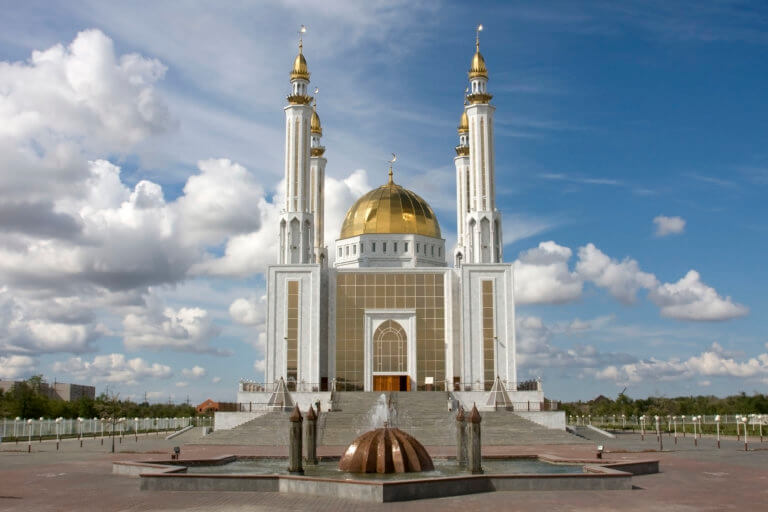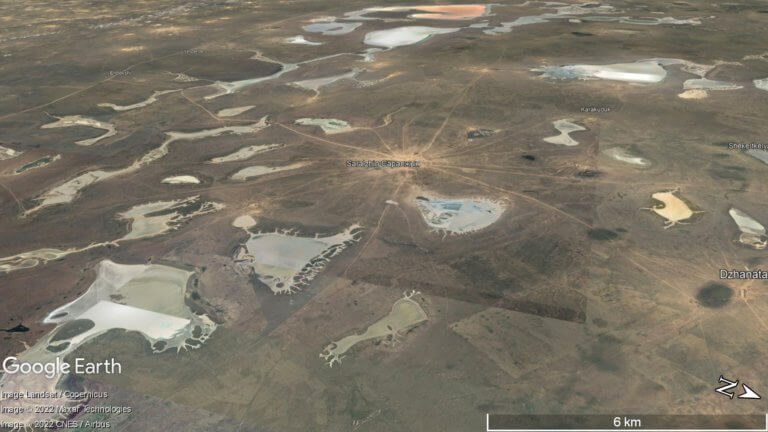
Aktobe
Aktobe is on the western end of the Kazakh Steppe, less than 100km from the Russian border. As the capital city of the Aktobe Region,
Less than 20km east of the Ural River is Inder Lake. It’s the second-largest lake in western Kazakhstan after Shalkar Lake, which is 230km+ further north and nearer to Oral city.
Springs and groundwater flowing from the nearby Inder Mountains feed the 10-kilometre-wide lake, particularly in the spring with snowmelt. Although it’s too shallow to swim in, it’s worth visiting just to see its picturesque snow-white shoreline or to beat the summer heat. Many come to rejuvenate their skin and joints too, by bathing in the lake’s mud, which is rich in bromine, potassium, and boron salts.
For the best views, head to the north and east shores, as it has cliffs rising 20m above the lake and over 80 mineral-rich springs. One of the most popular springs for therapeutic use is Tilepbulak on the north coast.
Peter Simon Pallas, a late 18th-century Prussian zoologist, was the first to record the Inder District’s biodiversity in his book, Journey through Various Provinces of the Russian Empire. Many of Pallas’ recorded species remain here today, such as the sunwatcher (Phrynocephalus helioscopus) and rapid fringe-toed lizard (Eremias velox).
In the 19th century, Prussian biologist-explorer Eduard Eversmann, as well as Russians Alexander Strauch (herpetologist), Mikhail Dmitrievich Ruzsky (zoologist), and Hugo Theodor Christoph (entomologist) conducted additional research. Between them, they identified several snake species such as the steppe rat snake (Elaphe dione), dwarf sand boa (Eryx miliaris), and the steppe viper (Vipera renardi). Fortunately, snakes are extremely wary of humans, so you’re unlikely to encounter any during your visit. However, keep your eye out for them during sunrise and sunset, as this is when they’re most active.
There are nearly 30 species of mammal in the region. Apex predators include saiga, jerboa, ferrets, and long-eared hedgehog, and predators include lesser white-toothed shrew, steppe and marbled polecats, European badger, corsac fox, wolf, raccoon dog, and red fox.
The Inder Mountains cover a 15km x 25km area of land on the north shore of the lake. It’s the largest area of karst in the Kazakh Caspian Lowland and has 200 to 300 karst features per square kilometre. Despite its name, the mountains are low-lying hills peppered with depressions, ridges, and small craters less than 30m above sea level. The lake shore is –15m below sea level. Geologically, the area is a mixture of gypsum and limestone rock, 10–15m thick salt deposits, and karst features formed through dissolution and bedding plane collapse. The region also has nearly 50 types of minerals, including rare ones such as inderite, inderborite, and preobrazhenskite.
Borate and gypsum mines dot the landscape. A few of the disused quarries, some of which began operation in the 1930s, are a popular hangout spot for Inderbor village locals and easily reached by car. The nearest one is less than 4km from the north shore and has a lake.
The Russian Geographical Society’s Astrakhan branch has undertaken several trips to explore the Inder Mountain caves. Of their half-a-dozen discoveries, the 25-metre-deep ‘Ice Fern Cave’ is the most intriguing, as it’s the only known cave in the north Caspian region to have ice year-round. Undoubtedly, there are plenty more caves yet to be discovered.
Inder is a two-hour drive north of Atyrau and a four-hour drive from Oral. You can also approach it from the east via remoter rural roads running through the Aktobe Region and eastern Atyrau Region.
Unlike Shalkar Lake, which has cabins and gers to rent, there’s no accommodation at Inder Lake. Inderbor village’s Aksay Hotel, on 10 Makhambet Street, is the nearest place to stay and less than 10km from the shore. Another option is Ak Zhol Hotel, 1.5km further south on the P-103 road leading to the village. You can camp in the area surrounding the lake, but don’t forget to bring drinking water!
Near the east coast, there’s Kizaylie Ata, a small necropolis. Accessible via a dirt road, it offers a peaceful and suitable spot for camping.
Inder Lake (İnder Kölı/Озеро Индер): 48.4654, 51.9226
Tilepbulak Spring (Tılepbūlaq/Родник Тилеп): 48.5137, 51.8746
Makhambet Utemisov Mausoleum (Mahambet Ötemısūly Kesenesı/Мавзолей Махамбета Отемисулы): 48.3605, 52.0792
Kizaylie Ata Necropolis (Qyzaili Ata Qorymy/Некрополь Кизайлие-Ата): 48.4685, 51.9997
Azilkhan Vahitov’s 360-degree aerial photos of the Inder Mountains and Inder Lake east shore.
1:200k Soviet map of Inder Lake, shown on the far right.

Aktobe is on the western end of the Kazakh Steppe, less than 100km from the Russian border. As the capital city of the Aktobe Region,

Overlooking Dead Kultuk is New Alexander Fort. It’s on the cliff edge of the Western Chink Ustyurt, on the east side of Kaydak Bay, and

At the northern edge of the Ryn Desert is Kamysh-Samara. The 60km x 100km plain was once home to at least a dozen lakes, with
Copyright © Planet Esoterica, 2024. No part of this site, www.planetesoterica.com, may be reproduced in whole or in part in any manner without the permission of the copyright owner. All rights reserved.
Made with 